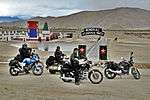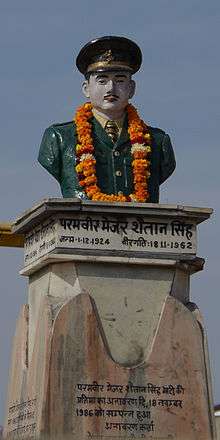Rezang La
Rezang La is a mountain pass on the south-eastern approach to Chushul Valley in the union territory of Ladakh in India. It is 3,000 yards long and 2,000 yards wide, with an average height of 16,000 feet. La means a mountain pass in Tibetan language.
| Rezang La | |
|---|---|
| रेजांग ला | |
 Location of Rezang La in Ladakh  Rezang La (India) | |
| Elevation | 5,199 m (17,057 ft) |
| Location | Ladakh, India |
| Range | Himalaya, Ladakh Range |
| Coordinates | 33°31′07″N 78°43′51″E |

1962 battle
Rezang La was the site of the last stand of the 13 Kumaon, during the Sino-Indian War in 1962. The company was led by Major Shaitan Singh, who won a posthumous Param Vir Chakra for his actions.[1] From the Indian point of view, Rezang La had the drawback that an intervening feature blocked artillery operation, so that the Indian infantry had to do without artillery cover.[1]
In this action on 18 November 1962, 114 Indian soldiers out of a total of 120 were killed. A memorial in Rewari, where most of the soldiers came from, mentions that 1,300 Chinese soldiers were killed in the battle.[2] The Indian side was led by Major Shaitan Singh (IC 7990), who was later posthumously awarded Param Vir Chakra, India’s highest gallantry award for conspicuous bravery and self-sacrifice in the face of the enemy.
Please note this is about the text of this Wikipedia article; it should not be taken to reflect on the subject of this article.
Do not restore or edit the blanked content on this page until the issue is resolved by an administrator, copyright clerk or OTRS agent.
If you have just labeled this page as a potential copyright issue, please follow the instructions for filing at the bottom of the box.

The previous content of this page or section has been identified as posing a potential copyright issue, as a copy or modification of the text from the source(s) below, and is now listed on Wikipedia:Copyright problems :
Unless the copyright status of the text on this page is clarified, the problematic text or the entire page may be deleted one week after the time of its listing (i.e. after 21:53, 1 July 2020 (UTC)).
Temporarily, the original posting is still accessible for viewing in the page history.
- You must permit the use of your material under the terms of the Creative Commons Attribution-Sharealike 3.0 Unported License (CC-BY-SA) and the GNU Free Documentation License (GFDL) (unversioned, with no invariant sections, front-cover texts, or back-cover texts).
- Explain your intent to license the content on this article's discussion page
- To confirm your permission, you can either display a notice to this effect at the site of original publication or send an e-mail from an address associated with the original publication to permissions-en

- Note that articles on Wikipedia must be written from a neutral point of view and must be verifiable in published third-party sources; consider whether, copyright issues aside, your text is appropriate for inclusion in Wikipedia.
Your rewrite should be placed on this page, where it will be available for an administrator or clerk to review it at the end of the listing period. Follow this link to create the temporary subpage.
- Simply modifying copyrighted text is not sufficient to avoid copyright infringement—if the original copyright violation cannot be cleanly removed or the article reverted to a prior version, it is best to write the article from scratch. (See Wikipedia:Close paraphrasing.)
- For license compliance, any content used from the original article must be properly attributed; if you use content from the original, please leave a note at the top of your rewrite saying as much. You may duplicate non-infringing text that you had contributed yourself.
- It is always a good idea, if rewriting, to identify the point where the copyrighted content was imported to Wikipedia and to check to make sure that the contributor did not add content imported from other sources. When closing investigations, clerks and administrators may find other copyright problems than the one identified. If this material is in the proposed rewrite and cannot be easily removed, the rewrite may not be usable.
- Posting copyrighted material without the express permission of the copyright holder is unlawful and against Wikipedia policy.
- If you have express permission, this must be verified either by explicit release at the source or by e-mail or letter to the Wikimedia Foundation. See Wikipedia:Declaration of consent for all enquiries.
- Policy requires that we block those who repeatedly post copyrighted material without express permission.
If you have tagged the article for investigation, please complete the following steps:
- Add the following to the bottom of Wikipedia:Copyright_problems/2020 June 24
* {{subst:article-cv|Rezang La}} from https://books.google.com/books?id=uzizVBSb4YsC&pg=PA73&lpg=PA73#v=onepage&q&f=false. ~~~~ - Place this notice on the talk page of the contributor of the copyrighted material:
{{subst:Nothanks-web|pg=Rezang La|url=https://books.google.com/books?id=uzizVBSb4YsC&pg=PA73&lpg=PA73#v=onepage&q&f=false}} ~~~~ - To blank a section instead of an entire article, add the template to the beginning of the section and {{Copyvio/bottom}} at the end of the portion you intend to blank.
Rezang La Memorials
A memorial was constructed near Dharuhera Chowk in Rewari city, Rezang La Park in Rewari City by Rezangla Shaurya Samiti. Every year, memorial functions are held by the Samiti in collaboration with district administration and the Kumaon Regiment, and family members of those who died at Rezangla also take part.
The inscription on the War Memorial at Chushul, Ladakh raised by the Indian Army in memory of the soldiers who died in the Battle of Rezang La, reads:
How can a man die better,
Than facing fearful odds,
For the ashes of his fathers,
And temples of his gods.
To the sacred memory of
the heroes of Rezang-La
114 martyrs of 13 Kumaon
who fought
to the last man last round
against hordes of Chinese
on
18 November 1962.
Built by all ranks
13th Battalion the Kumaon Regiment.[5][6]
The first four lines are quoted from Horatius, a poem by Lord Thomas Babington Macaulay, member of the Governor-General of India's Supreme Council from 1834 to 1838[7]
- In his book 'Param Vir, Our Heroes in Battle' Major-General Ian Cardozo writes:
- "When Rezang La was later revisited dead jawans were found in the trenches still holding on to their weapons... every single man of this company was found dead in his trench with several bullets or splinter wounds. The 2-inch mortar man died with a bomb still in his hand. The medical orderly had a syringe and bandage in his hands when the Chinese bullet hit him... Of the thousand mortar bombs with the defenders, all but seven had been fired and the rest were ready to be fired when the (mortar) section was overrun.".
- General T.N. Raina said:
- "You rarely come across such example in the annals of world military history when braving such heavy odds, the men fought till the last bullet and the last man. Certainly, the Battle of Rezang La is such a shining example."[8]
- General K S Thimayya remarked, I hope a suitable memorial will be built in Ahirwal in their memory so that the generations to come may seek inspiration from the immense courage and valour of their forefathers."[8]
References
- Mohan Guruswamy (20 November 2012). "Don't forget the heroes of Rezang La". The Hindu. Retrieved 28 March 2015.
- "Nobody believed we had killed so many Chinese at Rezang La. Our commander called me crazy and warned that I could be court-martialled". The Indian Express. Retrieved 8 April 2016.
- "Major Shaitan Singh (Posthumous) 13 KUMAON (1962)". Official Website of Indian Army. Retrieved 8 April 2016.
- Subramanian, L.N. (November–December 2000). "The Battle of Chushul". Bharat Rakshak Monitor. 3 (3). Archived from the original on 2 February 2007. Retrieved 24 April 2007.
- "Archived copy". Archived from the original on 28 January 2014. Retrieved 19 January 2014.CS1 maint: archived copy as title (link)
- "Archived copy". Archived from the original on 2 February 2014. Retrieved 19 January 2014.CS1 maint: archived copy as title (link)
- Thomas Babbington Macaulay. "Lays of Ancient Rome". Gutenberg.org. Retrieved 8 April 2016.
- Tribune India
